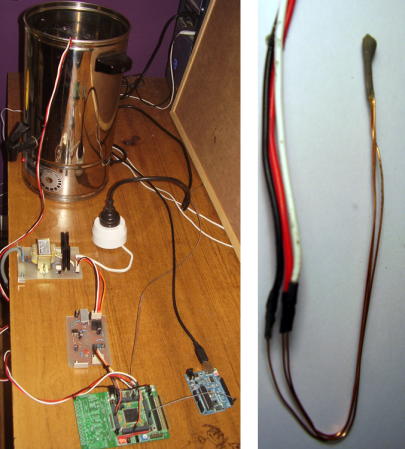
Hackaday Alum [Nick Schulze] decided to help out a friend who needed a controller to hold water at a precise temperature. Coffee guzzling hackers of the world should rejoice, as [Nick] targeted a coffee urn as the vessel for the project. What he came up with was a couple of custom boards and a roll-your-own temperature probe which does a fantastic job of regulating the temperature of the liquid.
Needing to switch the mains going to the heating element he immediately thought of an AC chopper circuit based on a Triac. What didn’t come to mind immediately was the need to detect the zero crossing. In the image above you can see nearest the urn his high voltage board. Below that is the zero crossing detector circuit. For feedback he created his own temperature probe using a TC1047 temperature sensor. After soldering on a filtering cap and the leads he dipped it in JB Weld to make it water tight. If you’re using this for coffee may we recommend seeking out a food safe probe.
After successful testing he added a user interface and buttoned it up in the enclosure seen in the video below.
http://www.youtube.com/watch?v=CbBa9eyjocI
















Why go through all of this when PID temperature controllers already work great?
http://www.kegkits.com/MYPIN%20TA4%20Programming.htm
My thoughts exactly, you can buy lots of used and very nice pid temp controls on ebay for less than he paid for the arduino. No sense reinventing the wheel.
95% of *duino projects are more costly in parts / labour / time than just buying the thing that already does that. Hell, when Raspberry Pi’s are cheaper than *duinos I am at a loss as to why they ever get used for anything…
To the child with a hammer, every problem is a nail.
Lots of reason not to use a RasPi. The instant turn-on of an arduino is one.
but is it RFC 2324 compliant?
http://tools.ietf.org/html/rfc2324
Not without an additional interface but if you want to go there some PIDs support external control.
COFFEE!
Instead of using phase angle control, I recommend switching only during zero crossings, and switching by whole or half cycles. This greatly reduces interference.
Zero crossing detection can also be done much smaller by a an optocoupler, with a capacitor + resistor in series to limit current, and an anti-parallel diode to prevent reverse voltage breakdown.
Someone forgot the picture of Fry on this post.
… they remembered on the other half-dozen.
Never mind, this one was expertly hidden. :)
The fuzzy logic controller seems a lot like a proportional controller in disguise. You’d be better off replacing it with a PI controller. Much simpler, less swings, and no offset.
“After soldering on a filtering cap and the leads he dipped it in JB Weld to make it water tight. If you’re using this for coffee may we recommend seeking out a food safe probe.”
Perhaps it is worth mentioning that JB Weld is non-toxic.
OK, you eat some JB weld and let us know how you get on.